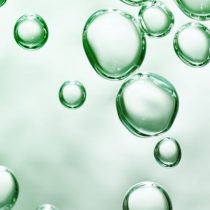
Humanity has been forced to face major environmental challenges in the coming decades, stemmed from the massive use of fossil fuels (coal, oil and gas) since the Industrial Revolution in the mid-18th century. They still cover about 85% of global energy demand.
Fossil fuels are nothing more than energy vectors, that is, energy carriers, which is released when reacting with oxygen. This reaction, called combustion, produces carbon dioxide, primarily responsible for the greenhouse effect and global warming.
Replacing these polluting energy vectors with environmentally friendly ones – so-called green fuels – is the only way to avoid the serious environmental effects associated with climate change that are already beginning to manifest in the form of droughts, floods and fires, among others.
Brown hydrogen and green hydrogen
The vast majority of hydrogen (H2) produced is obtained by the rupture of the water molecule in oxygen and hydrogen.
Although hydrogen combustion generates only water, around 95% of what is currently produced is of brown hydrogen type, since fossil fuels are used in its production and therefore CO2 is emitted.
Thus, achieving the decarbonisation targets set by the European Commission over the next thirty years means radically increasing the production of so-called green hydrogen. It is produced using energy from sustainable sources (such as wind, photovoltaic, geothermal, thermosolar, tidal) to achieve the breakdown of the water molecule.
In addition, the integration of these sustainable energy sources with hydrogen production systems helps to alleviate some of the fundamental limitations of the former, such as intermittency and the possible gap between production and demand. The hydrogen produced stores the excess energy, which will be released later.
Hydrogen production technologies
Water rupture can be carried out using different approaches: by thermochemical cycles (using steam at intermediate and high temperatures), liquid water electrolysis (low temperature), water vapour electrolysis (high temperature), photochemically, etc.
Thermochemical cycles consist of at least two stages:
In the first, a metal oxide is reduced (loses some of the oxygen it contains) by heating into a suitable gas.
In the second stage, water vapour is reacted with reduced oxide. In this way, the oxygen of the water is incorporated into the metal oxide and hydrogen is released in the form of H2 molecules.
If system heating is achieved with concentration thermosolar energy, i.e. concentrating solar radiation with suitable optical devices, fully green hydrogen is produced.
In different electrolysis technologies, water molecules are broken by applying electrical energy. There are two major types of water electrolysts, very different and with disparate degrees of maturity:
Those who work with water vapour around 800oC. They are at a demonstration stage or as pre-commercial prototypes.
Those who work with liquid water (called low temperature). They are commercial systems and there are already industrial facilities that use them to produce hydrogen in large volumes.
In turn, there are two types of low-temperature electrolysts: those that work in acidic mediums and those that work in basic media. The latter are the most abundant as they do not need precious metals such as platinum or iridium, which is essential for the former.
Other approaches are being explored to produce water rupture, but they do not yet pass the laboratory level.
Storage and transport
The massive use of hydrogen as fuel requires that it be safely stored, transported and used where it is needed and for the applications that demand it. Storage and distribution present problems associated with low density and boiling temperature of hydrogen.
For storage there are two types of methods: those based on physical properties (pressure gas, cooled pressure gas and liquid) and those based on the formation of compounds with a large amount of hydrogens.
Both types of methods have drawbacks. The first associated with the risk of handling systems at high pressure and low temperatures. The latter, to the need to obtain a compound that is subsequently decomposed releasing hydrogen.
An aprosimilar to this second method is the use as fuel of the obtained compound. The most successful case is ammonia, which can be used in combustion engines.
For the transport of hydrogen, physical solutions similar to those discussed in relation to storage are proposed. In addition, special pipe transport networks are built, or hydrogen-mixed with natural gas and pipelines are used for transport and separating the mixture at destination. All these approaches have limitations yet to be solved.
How do you get hydrogen energy?
Hydrogen combustion can be done through two methods:
Directly, through a chemical process with heat production (in a combustion engine similar to that used for the use of fossil fuels).
By an electrochemical process in which the chemical energy of H2 is directly transformed into electricity. This process is carried out in a fuel cell (or battery) and is more efficient, but the necessary technology is still in development. Adapting the engines to the use of hydrogen seems simpler.
We are at a crucial time to address energy and environmental challenges. Green hydrogen is called to make a decisive contribution to the resolution of both. Achieving this means solving the problems that still persist in its production, storage, transport and use. The challenge is remarkable, but success will mean abundant, cheap and clean energy in the future.
Ulysses Julio Amador Elizondo, Professor of Inorganic Chemistry, CEU University San Pablo and Ma Teresa Azcondo, Professor of the Area of Inorganic Chemistry, CEU San Pablo University
This article was originally published in The Conversation. Read the original.





